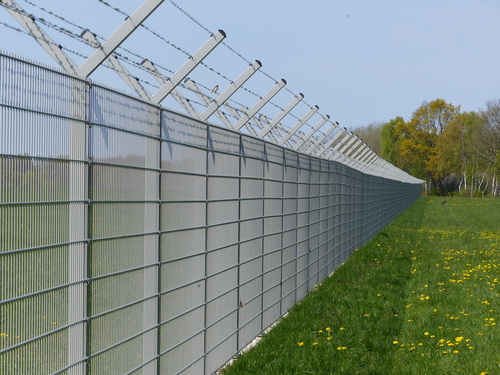Facilities managers should work with security professionals on developing an adequate security plan to protect the perimeter of their properties. Each property is unique, so highly secure locations, like military installations, will have a different plan than areas open to the public, like shopping centers.
1. Vehicle Access Control

Highly secure facilities should consider installing fencing near the property’s border to prevent unauthorized vehicles.
Here are some of the major types of vehicle access control systems, which could also be used for parking garages, according to the International City/County Management Association (ICMA):
- Guards: Personnel at entrances and exits can activate the gate after visitors show their identification.
- Keypad: Enter a code to gain access.
- License plate reader: The gate opens for vehicles based on their license plate.
- Radio frequency identification (RFID) card and key fobs: These can be scanned at a reader to enter.
- Smartphone: Visitors can download a smartphone app and point it at a reader to go in.
2. Locks
Determine what types of interior access control locks are needed to enter buildings or portions thereof. Locks that should be considered by facilities professionals include:
- Door locks: These include traditional lock mechanisms with or without deadbolts. Other options include having to push a combination of buttons or a dial-type combination lock.
- Keycards and fobs: Users need a fob or keycard to unlatch the lock.
- Biometrics: Biological attributes (like face, finger, iris, or voice) are for high-security areas. For additional security, utilize Bluetooth smartphone apps.
3. Video Cameras
Be sure to install and maintain cameras outside buildings, and consider the following three factors when installing them:
- Locations: These include secluded spots, access points, parking lots and garages, sidewalks, and areas that have been hit by vandals.
- Camera type: Decide between a fixed camera, which is focused on one point, and a controllable pan-tilt-zoom camera. Research whether a traditional analog or state-of-the-art network camera will be best.
- Video retention: Investigate digital video recorders and digital compression methods.
4. Lighting
Buildings that appear unoccupied because of a lack of exterior lighting are often targeted by criminals, so consider one or more of the following popular types of outdoor lighting:
- Floodlights flood dark areas outside a facility with light and can be found in large parking lots and along streets.
- Spotlights can provide narrow and concentrated light to illuminate building signage, as well as architectural and landscape elements.
- Wall lights can be affixed to a building’s walls and provide extra light around entrances and exits.
- Ceiling lights illuminate areas underneath awnings and canopies, as well as inside parking garages.
- Lamp posts can be installed in smaller parking lots and along sidewalks, while 3- to 4-foot-tall bollards are for concentrated lighting along walkways.
5. Maintenance
Facilities professionals should perform regular walking inspections of the property and should specifically look for:
- Breaches in perimeter barriers.
- Vulnerabilities to access control areas.
- Signs of vandalism, litter, or graffiti near the property line. Clean it up, even if it is on an adjoining property, to prevent the problems from spilling onto your facility.
Report any issues to upper management.
6. Security Canines
If your property is large, consider having security canines provide security in one of the following ways:
- Mobile drive-by: This can be either random or implemented at times of high risk and is especially helpful in remote areas to provide a quick response.
- Alarm: Canines will loudly bark when strangers approach, which usually intimidates unwanted visitors.
- Sentry: The canines can be trained to attack anyone who trespasses.
7. Patrolling
For noncanine solutions, consider one or more of the following:
- Desk duty: Security should be present at the facility’s main entrance and ensure visitors are authorized and signed in.
- Foot patrol: Security should walk through the site and maintain either a low profile, such as hiding to view possible suspicious activity, and a high profile, conducting visible walk-throughs of the area.
- Vehicle patrol: Consider this option to travel around more easily on large properties. In addition to motor vehicles, this also includes golf carts and bicycles.
- Robots and drones: Robots can monitor conditions inside facilities by doing dull, dirty, and dangerous duties, according to the Security Industry Association. Drones, which are airborne, can also have scheduled patrols and are helpful when inspecting intruder alarms and monitoring major events such as oil spills and fires.
8. Create an Emergency Response Team and Procedures
Facilities of all sizes should be prepared to handle any emergency. People from various departments should work together to create a team in which roles, resources, and technologies are defined. According to the U.S. Department of Homeland Security, these teams should be prepared to collaborate with the following personnel:
- Law enforcement
- Fire service
- Emergency medical services
- Hazardous materials
- Emergency management
- Public works
Overall, personnel at workplaces, businesses, and organizations can work together to ensure maximum perimeter security to safeguard not only themselves but also visitors.
